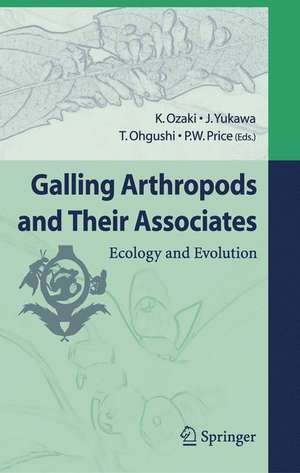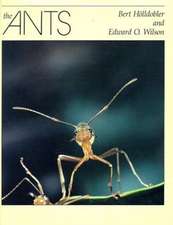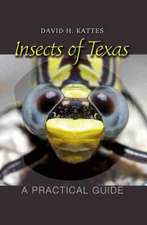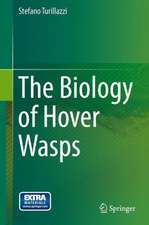Galling Arthropods and Their Associates: Ecology and Evolution
Editat de K. Ozaki, J. Yukawa, T. Ohgushi, P.W. Priceen Limba Engleză Hardback – 2 mai 2006
| Toate formatele și edițiile | Preț | Express |
|---|---|---|
| Paperback (1) | 1218.21 lei 6-8 săpt. | |
| Springer – 4 dec 2014 | 1218.21 lei 6-8 săpt. | |
| Hardback (1) | 1224.36 lei 6-8 săpt. | |
| Springer – 2 mai 2006 | 1224.36 lei 6-8 săpt. |
Preț: 1224.36 lei
Preț vechi: 1493.13 lei
-18% Nou
Puncte Express: 1837
Preț estimativ în valută:
234.27€ • 244.63$ • 193.46£
234.27€ • 244.63$ • 193.46£
Carte tipărită la comandă
Livrare economică 16-30 aprilie
Preluare comenzi: 021 569.72.76
Specificații
ISBN-13: 9784431321842
ISBN-10: 4431321845
Pagini: 322
Ilustrații: XIV, 308 p.
Dimensiuni: 155 x 235 x 22 mm
Greutate: 0.64 kg
Ediția:2006
Editura: Springer
Colecția Springer
Locul publicării:Tokyo, Japan
ISBN-10: 4431321845
Pagini: 322
Ilustrații: XIV, 308 p.
Dimensiuni: 155 x 235 x 22 mm
Greutate: 0.64 kg
Ediția:2006
Editura: Springer
Colecția Springer
Locul publicării:Tokyo, Japan
Public țintă
ResearchDescriere
This book is the result of an international symposium on gall-inducing arthropods, which was held September 5-9, 2005, in Kyoto, Japan. It was organized as the 4th international symposium on gall-inducing insects and as the symposium of the In ternational Union of Forestry Research Organizations (lUFRO) working group, 7.03.02, Gall-Inducing Insects. The book addresses recent developments in the ecology, evolution, systematics, physiology, and biodiversity of gall-inducing arthropods, with individual contri butions ranging in scope from detailed descriptions to profoundly synthetic stud ies. One underlying theme of the book is the various impacts of gall induction that indirectly affect insect communities on the host plant. The other important contri bution is the highly intricate and dynamic interactions between galling arthropods and their uniquely specialized host plants. Included also are chapters that discuss biodiversity and distribution patterns of gall-inducing arthropods, and biological control of invasive gall-inducing arthropods and of invasive trees. We believe that this book makes an important contribution to the knowledge of galling arthropods and their associates and to the development of robust, general principles of the ecology and evolution of these organisms.
Cuprins
Preface Part 1 Biodiversity and Community Structure: Latitudinal and Altitudinal Patterns in Species Richness and Mortality Factors of the Galling Sawflies on Salix Species in Japan.- Species Richness of Eriophyid Mites on Finnish Trees and Shrubs.- Diversity, Biology, and Nutritional Adaptation of Psyllids and their Galls in Taiwan.- Trophic Shift in d15N and d13C through Galling Arthropod Communities: Estimates from Quercus turbinella and Salix exigua.- Temporal Variation in the Structure of a Gall Wasp Assemblage along a Genetic Cline of Quercus crispula (Fagaceae).- Effects of Floods on the Survival and Species Component of Rhopalomyia Gall Midges (Diptera: Cecidomyiidae) Associated with Artemisia princeps (Asteraceae) Growing in a Dry Riverbed in Japan.- Guild Structure of Gall Midges on Fagus crenata in Relation to Snow Gradient: Present Status and Prediction of Future Status as a Result of Global Warming.- Part 2 Biological Control and Galling Arthropods: Early Parasitoid Recruitment in Invading Cynipid Galls.- Parasitoid Recruitment to the Globally Invasive Chestnut Gall Wasp Dryocosmus kuriphilus.- Cynipid Gall Wasps in Declining Black Oak in New York: Relationships with Prior Tree History and Crown Dieback.- Gall-forming Cecidomyiidae from Acacias: Can New Parasitoid Assemblages be Predicted?.- Recent Outbreaks of the Maize Orange Leafhopper Cicadulina bipunctata Inducing Gall-like Structures on Maize in Japan.- Part 3 Galling Arthropods - Plant Interactions: Different Oviposition Strategies in Two Closely Related Gall Midges (Diptera: Cecidomyiidae): Aggregation versus Risk Spreading.- A Protective Mechanism in the Host Plant, Aucuba, against Oviposition by the Fruit Gall Midge, Asphondylia aucubae (Diptera: Cecidomyiidae.- Genetic Variation in the Timing of Larval Mortality and Plant Tissue Responses Associated with Tree Resistance against Galling Adelgids.- Variable Effects of Plant Module Size on Abundance and Performance of Galling Insects.- Biology and Life History of the Bamboo Gall Maker, Aiolomorphus rhopaloides Walker (Hymenoptera: Eurytomidae.- Effects of Host-tree Traits on the Species Composition and Density of Galling Insects on Two Oak Species, Quercus crispula and Quercus serrata (Fagaceae).- Part 4 Indirect Effects of Galling Arthropods: Positive Indirect Effects of Biotic- and Abiotic-mediated Changes in Plant Traits on Herbivory.- Deer Browsing on Dwarf Bamboo Affects the Interspecies Relationships among the Parasitoids Associated with a Gall Midge.- Influence of the Population Dynamics of a Gall-inducing Cecidomyiid and Its Parasitoids on the Abundance of a Successor, Lasioptera yadokariae (Diptera: Cecidomyiidae).- Part 5 Evolution and Taxonomy: Evolution of Wing Pigmentation Patterns in a Tephritid Gallmaker: Divergence and Hybridization.- The Evolution of Gall Traits in the Fordinae (Homoptera).- Life History Patterns and Host Ranges of the Genus Asphondylia (Diptera: Cecidomyiidae).- Taxonomic Status of the Genus Trichagalma (Hymenoptera: Cynipidae), with Description of the Bisexual Generation.- Phylogenetic Position of the Genus Wagnerinus Korotyaev (Coleoptera: Curculionidae) Associated with Galls Induced by Asphondylia baca Monzen (Diptera: Cecidomyiidae).- Index
Caracteristici
Represents an important contribution to the knowledge of galling arthropods
Explores the highly intricate and dynamic interactions between galling arthropods and their specialized host plants
Discusses biodiversity and distribution patterns of gall-inducing arthropods
Covers biological control of invasive species
Explores the highly intricate and dynamic interactions between galling arthropods and their specialized host plants
Discusses biodiversity and distribution patterns of gall-inducing arthropods
Covers biological control of invasive species








